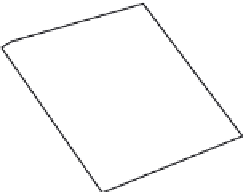Graphics Reference
In-Depth Information
linkage. Inverse kinematics can then be used to step from one pose to the next so that the arm is still
guided along the path. This affords some of the savings of using inverse kinematics while giving the
animator more control over the final motion.
The formal inverse Jacobian approach can be replaced with a more procedural approach based on
the same principles to produce more human-like motion. In human motion, the joints farther away from
the end effector (the hand) have the most effect on it. The joints closer to the hand change angles in
order to perform the fine orientation changes necessary for final alignment. This can be implemented
procedurally by computing the effect of each DOF on the end effector by taking the cross-product of the
axis of rotation,
o
1
, with the vector from the joint to the end effector,
V
1
(
Figure 9.7
)
. In addition, since
the arm contains a one DOF angle (elbow), a plane between the shoulder, the elbow, and the wrist is
formed, and the arm's preferred positions dictate a relatively limited rotation range for that plane. Once
the plane is fixed, the shoulder and elbow angles are easy to calculate and can be easily adjusted on that
plane (
Figure 9.8
). Some animation packages (e.g., Maya
TM
) allow the animator to specify an inverse
kinematic solution based on such a plane and to rotate the plane as desired.
ders [
61
]
, suggest that the arm's posture is determined from the desired location of the end effector
(roughly “fixing the wrist's orientation”), and then the final wrist orientation is tweaked for the nature
R
1
P
1
V
1
ω
1
FIGURE 9.7
Effect of the first DOF on the end effector:
R
1
¼ o
1
V
1
.
Desired end effector position
Shoulder
position
Desired plane of arm (user specified)
Arm configuration constructed in the plane
FIGURE 9.8
Constructing the arm in a user-specified plane.



























Search WWH ::

Custom Search